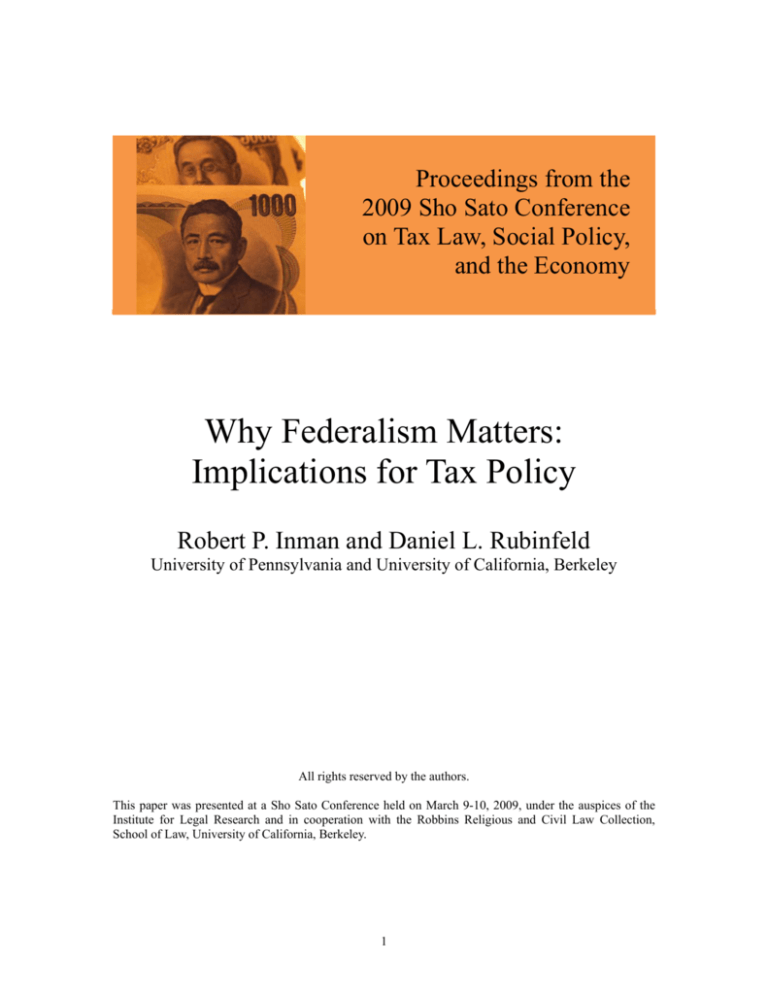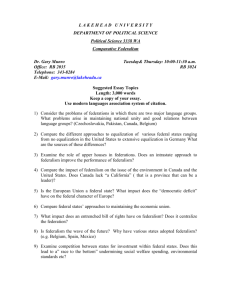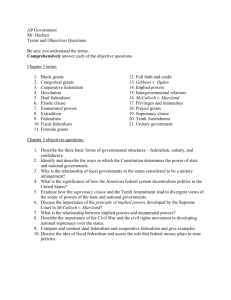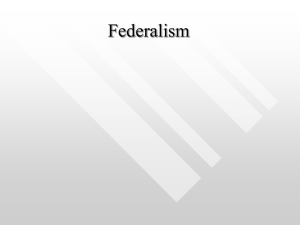
Proceedings from the
2009 Sho Sato Conference
on Tax Law, Social Policy,
and the Economy
Why Federalism Matters:
Implications for Tax Policy
Robert P. Inman and Daniel L. Rubinfeld
University of Pennsylvania and University of California, Berkeley
All rights reserved by the authors.
This paper was presented at a Sho Sato Conference held on March 9-10, 2009, under the auspices of the
Institute for Legal Research and in cooperation with the Robbins Religious and Civil Law Collection,
School of Law, University of California, Berkeley.
1
Proceedings from the 2009 Sho Sato Conference on Tax Law
Why Federalism Matters:
Implications for Tax Policy
1
Robert P. Inman and Daniel L. Rubinfeld
1. Introduction
Many of the world’s nation states are Federal systems in which there is a sharing of
powers, including the power to tax, between a central government and lower-tier, provincial or
state governments. However, other nations are unitary with most or all power at the center. Does
the allocation of taxing powers matter for economic growth, for the ability to achieve the desired
level of redistribution, or for the efficient allocation of public services? If so, is a Federal system
to be preferred?
Many scholars who would almost certainly say yes; they include economists Wallace
Oates (1972), James Buchanan (1995), and Roger Myerson (2006), as well as political theorist
Barry Weingast (1995 and 2006). However, others might well disagree; they include Malcolm
Feeley and Edward Rubin (1994 and 2007), William Riker (1964) and Alberto Alesina and Enrico
Spolaore (2005).
In this brief note, we highlight a number of our views on this fundamental political
economy question and its implications for tax policy.2 We begin with a brief description of the
federalism dilemma wherein a nation’s choice of a constitutional framework depends on the
extent of its economic development. We then define four distinct federal structures that
characterize the world’s nation states. The presentation moves to our empirical study, which
involves a panel study of 73 countries over a 35-year time period. Our preliminary findings
support the view that decentralization does bring with it a number of substantial social benefits.
2. The Federalism Dilemma
As nation states evolve and new nations are born, it is natural to ask three fundamental
design questions. First, how many local and state governments should there be? Second, how will
they be represented in the central government? Third, how should taxing and spending
responsibilities be allocated among the central and lower tiers?
With respect to taxation in particular, our answer depends crucially on whether the
nation is a mature or a developing economy. Within the confines of a mature nation state, the
constitutional planner has greater flexibility in the choice of feasible policy instruments and in
many cases fewer fundamental objectives (e.g., macroeconomic goals may have been achieved or
will be seen as manageable). However, in a developing economy, redistribution is likely to be at
least as important as efficiency in taxing and spending. Moreover, local units of government may
not have the training or sophistication to manage substantial tax revenues and to organize the
provision of locally-provided public goods.
1
Robert P. Inman is Professor of Finance; Professor of Finance and Economics, Business and Public
Policy, Law and Economics, The Wharton School, University of Pennsylvania; and Daniel L. Rubinfeld is
Professor of Law and Professor of Economics, University of California, Berkeley.
2
The note relies heavily on a chapter of our planned volume on the political economy of federalism.
2
Proceedings from the 2009 Sho Sato Conference on Tax Law
Our studies of federalism in the United States and throughout the world have convinced
us of the advantages that lie in an economy that has a federalist structure. Federalism allows one
to achieve a range of social goals, relating to redistribution, political participation, and various
efficiencies, including the achievement of scale economies, the matching of benefits to costs, and
the innovation flowing from competition among subnational governmental units. Furthermore,
within a federal system subnational governments can check central government abuses and
promote individual rights and liberties. We are comfortable, therefore, with the principle of
subsidiarity. Subsidiarity requires that one allocate spending and taxing responsibilities to the
smallest geographical and/or population jurisdictions that can raise taxes most efficiently and in
the process provide the desired level of service quality at the lowest cost per citizen.
Within mature economies, the now standard economists’ prescriptions for efficiency are
eminently sensible. One should level broad-based taxes at the center, which should take primary
responsibility for the redistributive function. Subnational provincial governments, especially local
governments, should focus on efficiency. They should levy benefits taxes (including user fees)
whenever possible. Some redistributive functions – those that benefit from direct ties between
service providers and recipients – are best provided locally. However, those local functions
should be limited in scope.
Even a quick survey of the world’s nation states tells us that the use of decentralized tax
revenues varies substantially among both mature and developing countries. But, does this really
matter? We suggest that the answer is yes, especially for developing nations.3
3. Governance Structures
To begin, we find it useful to distinguish among four forms of federal governance. These
are as follows:
1) Constitutionally Federal. Under this regime, there are two or more
constitutionally created provinces, there is constitutionally required representation
for those provinces in the central legislature, and there are significant policy
responsibilities for the states or provinces that operate at the subnational level.
2) De Facto Federal. Under this regime, there are two or more constitutionally
created provinces and significant policy responsibilities at the subnational level
(usually among only a few provinces). However, there is no constitutionally
guaranteed representation for the provinces in the central legislature and
consequently little or no political or economy power for the subnational units.
3
For a developing economy such as South Africa, we have supported a gradual move to a decentralized
system. As Inman and Rubinfeld (2005) describe, in the South African federal system, provinces have
substantial power over spending, but most tax revenues are raised at the center. Central taxation allows for
substantial redistribution, while provincial control over spending serves to protect the white minority from
exploitation by the non-white majority.
3
Proceedings from the 2009 Sho Sato Conference on Tax Law
3) Administrative Federalism. Under this regime, there is significant policy
decentralization of taxation and spending functions to regional and large local
governments, but there are no constitutionally created provinces and, by definition,
no representation of provinces in the central legislature.
4) Unitary.: Under this regime, there is a single nation state and significant policy
centralization. There are no provinces, and by definition no provincial representation to
the central legislature.
Examples of constitutionally federal countries are the United States, Canada, Germany,
Mexico, Nigeria, and Pakistan, of de facto federal countries are China, Italy, Japan, and the
Netherlands, and of administrative federal countries are Denmark, France, Norway, Sweden, and
Uruguay. Unitary governments have a single state, no provincial representation, and centralized
policy-making. Examples include Chile, Peru, New Zealand, the United Kingdom, Korea,
Thailand, Sierra Leone, and Zimbabwe.
4. The Empirical Evidence
To evaluate the question of whether federal systems with substantial decentralization of
taxing and spending authorities do generate preferred outcomes to unitary and other more
centralized systems, we have undertaken a substantial empirical study. We are motivated by
William Riker’s proposal to find many matched pairs of countries, one federal and one unitary,
and to compute the average difference in their performance for a variety of valued country
outcomes. The key, of course, is to define the relevant dimensions on which the countries should
be matched and then to find enough matched pairs of federal and unitary countries so that we can
be confident that the average differences in performance are real.
Riker’s empirical evidence was limited; he drew his conclusions from a comparison of
six, reasonably chosen pairs and found no real differences in country performance between
federal and unitary countries. Our sample contains within it over thirty pairs of federal and
unitary countries, including all the world’s federalist nations, and we are able to match more
precisely than could Riker.
In total, our sample consists of data for 73 countries, including all of the world’s
federalist countries, with outcomes measured over the period from 1965 through 2000.4 A key
variable in the analysis is the degree of policy decentralization. We use the share of lower-tier
revenues as our measure of policy decentralization under the belief that own local government
revenues carry with them greater local policy discretion.5
4
There is relatively little change in governance structures over time; most of the relevant variation is
cross-sectional.
5
The share of all government spending which is done locally might also be used, but this share includes
central-to-local intergovernmental aid and such assistance is often closely monitored by the central
government. In any case, local revenue shares and local expenditure shares are highly correlated (r = .81)
and a ranking of countries by expenditure shares gives the same federal classifications as revenue shares
are used.
4
Proceedings from the 2009 Sho Sato Conference on Tax Law
Ours is still a work in progress. However, our preliminary finding is that federal
institutions do matter. On average, federal systems have higher worker productivity and improved
protections for property, civil, and political rights of residents.6 What is particularly interesting,
however, is that the benefits associated with a federal system (relative to a unitary system) are
greatest when the system is democratic. The potential performance gains of adding federal
institutions to a unitary democracy are a substantial increase in national income per capita, in
worker productivity, a reduction in income inequality, an improvement in relative property rights
performance, and an improvement in relative political and civil rights performance.7
If federal systems do perform better, at least on some dimensions, why do they do so?
Our view is that policy decentralization is key and that the formal institutions of federalism,
particularly politically independent provincial governments, have important roles to play as
promoters for, and safeguards of, assigned local and provincial policy responsibilities.
Moving beyond these cross-country comparisons to a deeper understanding of exactly
how the institutions of federalism might lead to these favorable outcomes, and how the
institutions might be improved, remains our extensive research agenda.
6
For prior evidence on worker productivity, see Hall and Jones (1999).
7
For a related study from a different perspective, see Thornton (2007).
5
Proceedings from the 2009 Sho Sato Conference on Tax Law
References
Alesina, Alberto and Enrico Spolaore (2005), The Size of Nations, Cambridge: MIT Press.
Buchanan, James (1995), “Federalism as an Ideal Political Order and a Objective for
Constitutional Reform,” 25 Publius: The Journal of Federalism, Spring, pp. 19-27.
Feeley, Malcolm and Edward Rubin (1994), “Federalism: Some Notes on a National Neurosis, 41
UCLA Law Review, April, pp. 903-952.
Feeley, Malcolm and Edward Rubin (2007), Federalism, unpublished manuscript, 2007.
Hall, Robert and Charles Jones, “Why Do Some Countries Produce So Much More Output per
Worker?” Quarterly Journal of Economics, Vol. 114 (February, 1999) 83-116.
Inman, Robert P. and Daniel L. Rubinfeld (2005), “Federalism and the Democratic Transition:
Lessons from South Africa“ (with Robert P. Inman), 95(2) American Economic Review, May, pp.
39-43.
Myerson, Roger (2006), “Federalism and Incentives for Success of Democracy,” 1 Quarterly
Journal of Political Science, January, pp. 3-23.
Riker, William (1969), “Six Books in Search of a Subject or Does Federalism Exist and Does It
Matter?” 2(1) Comparative Politics, October, pp. 135-146.
Riker, William (1975), “Federalism,” 5 Handbook of Political Science, Governmental Institutions
and Processes, pp. 93-172.
Thornton, John (2007), “Fiscal Decentralization and Economic Growth Reconsidered,” 61
Journal of Urban Economics, January, pp. 64-70.
Weingast, Barry (1995), “The Economic Role of Political Institutions: Market-Preserving
Federalism and Economic Development,” 11 Journal of Law, Economics, and Organizations,
Spring, pp. 1-31.
Weingast, Barry (2006), “Second Generation Fiscal Federalism: Implications for Decentralized
Democratic Governance and Economic Development,” Mimeo, Hoover Institution, Stanford
University.
6









